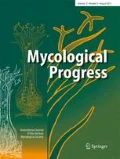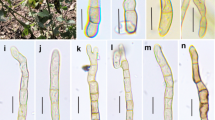Abstract
Lycoperdon rupicola and L. subumbrinum are here described as new species. The former is a morphologically characteristic species forming small subglobose to pyriforme fruiting bodies with a prominent, protruding and stellately lobed stoma. In the phylogenetic analyses the six sequences of L. rupicola form a clade with 100% BS and 1.0 BPP, clustering with L. dermoxanthum. The proposed species grows among mosses on siliceous boulders and flat rocks as well as on open, sandy soil in temperate and hemiboreal regions. The records to date indicate its presence in Fennoscandia and Spain (Catalunya). L. subumbrinum morphologically resembles L. umbrinum but differs in having coarser ornamentation of its spores. In the phylogenetic analyses the five sequences of L. subumbrinum form a clade with 100% BS and 1.0 BPP, clustering with L. muscorum. The records to date, originating from southernmost Sweden and NW Slovakia, indicate that L. subumbrinum is a species of rich deciduous forests.
L. muscorum is recorded for the first time from the Iberian peninsula (Spain).








Similar content being viewed by others
References
Bates ST (2004) The Arizona members of the Geastraceae and the Lycoperdaceae (Basidiomycota, Fungi). Thesis Arizona State University, http://www.azfungi.org/stbates/STBThesis1.pdf
Bates ST, Roberson RW, Desjardin DE (2009) Arizona gasteroid fungi I: Lycoperdaceae (Agaricales, Basidiomycota). Fungal Diversity 37:153–207
Demoulin V (1971) Le Genre Lycoperdon en Europe et en Amérique du Nord. Étude Taxonomique et Phytogéographique. Thesis. Université de Liège
Demoulin V (1972) Espèces nouvelles ou méconnues du genre Lycoperdon (Gastéromycètes). Lejeunia Nouvelle Série 62:28 pp.
Demoulin V (1979) The typification of Lycoperdon described by Peck and Morgan. Beih. Sydowia, Ann. Myc. Ser. II:Beih. VIII:139 – 151
Eckblad F-E (1955) The gasteromycetes of Norway. The epigaean genera. Nytt Mag Bot 4:19–86
Gube M (2009) Ontogeny and phylogeny of gasteroid members of Agaricaceae (Basidiomycetes). Thesis Friedrich-Schiller-Universität, Jena, http://deposit.d-nb.de/cgi-bin/dokserv?Idn = 999990691&dok_var = d1&dok_ext = pdf&filename = 999990691.pdf
Hollós L (1904) Die Gasteromyceten Ungarns. O. Weigel, Leipzig
Holmgren PK, Holmgren NH (1998, continuously updated) Index Herbariorum: A global directory of public herbaria and associated staff. New York Botanical Garden’s Virtual Herbarium, New York, http://sweetgum.nybg.org/ih/
Jeppson M (2006) The genus Lycoperdon in Greenland and Svalbard. In Boertmann D & Knudsen H (eds.):Arctic and alpine mycology 6. Meddelelser om Grønland. BioScience 56:106–127
Katoh K, Kuma K, Toh H, Miyata T (2005) MAFFT version 5: improvement in accuracy of multiple sequence alignment. Nuc Acids Res 33:511–518
Kreisel H (1962) Die Lycoperdaceae der Deutschen Demokratischen Republik. Feddes Repert. 64:89 – 201. Reprint 1973, Bibliotheca Mycologica 36. J. Cramer, Lehre
Kreisel H (1964) Vorläufige Übersicht der Gattung Bovista. Feddes Repert 69:196–211
Kreisel H, Karasch P (2005) Über Bovista acuminata und Morganella subincarnata – zwei bemerkenswerte Gasteromycetenfunde aus dem Alpenraum. Mycol Bav 8:9–15
Larsson E, Jeppson M (2008) Phylogenetic relationships among species and genera of Lycoperdaceae based on ITS and LSU sequence data from north European taxa. Mycol Res 112:4–22
Lloyd CG (1905) The genus Lycoperdon in Europe. Mycological Notes 19:205–217
Martín MP, García MA (2009) How many species in the Rhizopogon roseolus group? Mycotaxon 109:111–128
Martín MP, Jeppson M (2001) An interesting Lycoperdon affin to L. ericaeum. Revista Catalana de Micologia 23:47–50
Nilsson RH, Abarenkov K, Veldre V, Nylinder S, De Wit P, Brosche S, Alfredsson JF, Ryberg M, Kristiansson E (2010) An open source chimera checker for the fungal ITS region. Mol Ecol Resour 10:1076–1081
Nylander, JAA, 2004. MrModeltest v 2. www.ebc.uu.se/systzoo/staff/nylander.html, Evolutionary Biology Centre, Uppsala University
Perdeck AC (1950) Revision of the Lycoperdaceae of the Netherlands. Blumea 6:480–516
Ronquist F, Huelsenbeck JP (2003) MrBayes 3: Bayesian phylogenetic inference under mixed models. Bioinformatics 19:1572–1574
Sarasini M (2005) Gasteromiceti epigei. Associazione Micologica Bresadola, Trento
Šmarda F (1958) Lycoperdaceae. In Pilát, A. (red.): Gasteromycetes. Flora ČSR, ser. B1:392 – 526
Swofford DL (2003) PAUP*. Phylogenetic analysis using parsimony (*and other methods). Version 4. Sinauer Associates, Sunderland, MA
Ulvinen T (1997) Lycoperdaceae Chevall. In:Hansen, L. & Knudsen, H. (eds.):Nordic Macromycetes, vol. 3. Nordsvamp – Copenhagen:332 – 340
Acknowledgments
We are grateful to Carl-Gustav Bengtsson, Rolf-Göran Carlsson, Inger-Lise Fonneland, Sven-Åke Hanson, Michael Krikorev, Xavier Llimona, Tina Nordberg, August Rocabruna, Jan-Olof Tedebrand, Magnus Vetter, Leif Örstadius, and the curator at H for providing specimens for this study. The authors are further indebted to Jörgen Jeppson (photos), Nils Lundqvist and Oliver Smith for help with the Latin diagnoses and to Vincent Demoulin and Hanns Kreisel for examining and commenting on some of the specimens. Financial support for this study was received from The Swedish Taxonomy Initiative, ArtDatabanken, SLU Uppsala, Kapten Carl Stenholm’s foundation, and Flora Micologica Iberica (CGL2006-12732-CO2-01/BOS).
Author information
Authors and Affiliations
Corresponding author
Rights and permissions
About this article
Cite this article
Jeppson, M., Larsson, E. & Martín, M.P. Lycoperdon rupicola and L. subumbrinum: two new puffballs from Europe. Mycol Progress 11, 887–897 (2012). https://doi.org/10.1007/s11557-011-0804-8
Received:
Revised:
Accepted:
Published:
Issue Date:
DOI: https://doi.org/10.1007/s11557-011-0804-8




